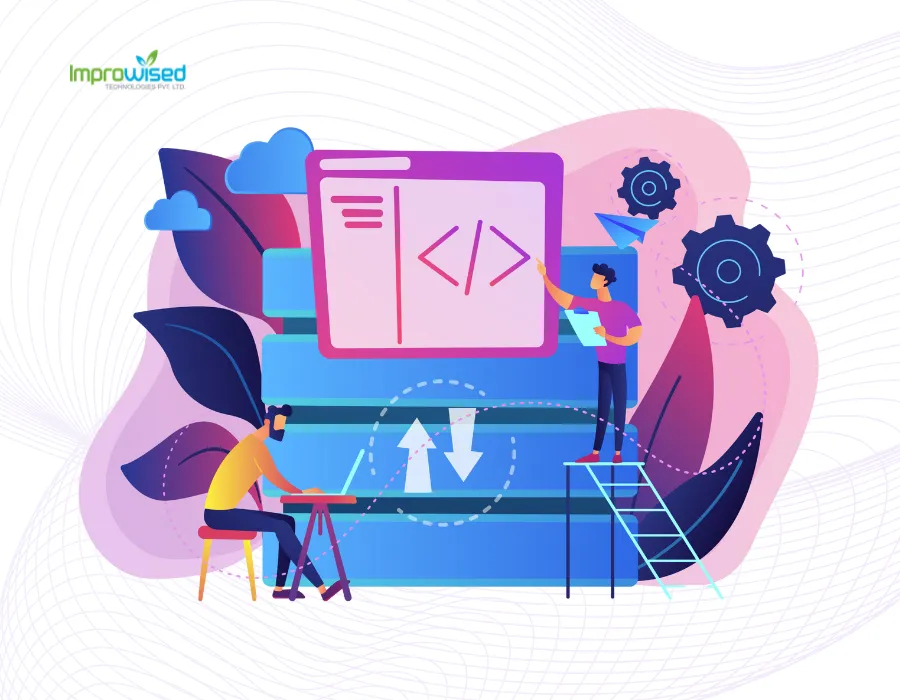February 21, 2025
Kubernetes: A Base, Not a Goal

By Rakshit Menpara
Improwised Technologies Pvt. Ltd.
Kubernetes: A Base, Not a Goal
Kubernetes is no longer a fringe technology; it’s becoming the core portion of the infrastructure for modern apps. People all over the world use Kubernetes to operate cloud-native systems, but it’s important to remember that it was never designed to be the final goal. Now, engineering teams who plan ahead see Kubernetes as a building block, not the ultimate goal. It’s a method to make platforms that are scalable, safe, and easy for developers to use, which leads to new ideas.
But the main goal is to make a platform product that encourages ongoing innovation and works without any difficulties.
This blog will talk about how Kubernetes has changed over time, how it works as a core layer, and why platform engineering goes beyond Kubernetes to focus on developer experience, automation, and operational excellence.
A Brief History of Kubernetes
Google made Kubernetes in 2014, and it was based on their own cluster manager, Borg. Joe Beda, Brendan Burns, and Craig McLuckie made Kubernetes open source and offered it to the Cloud Native Computing Foundation (CNCF) to run in a way that doesn’t favor any one enterprise. This choice helped Kubernetes develop from a niche orchestrator to the global standard for container management.
Time line Main Points:
- In 2014, Google released Kubernetes free to use.
- The Cloud Native Computing Foundation (CNCF) was set up in 2015, and Kubernetes was its first project.
- The ecosystem increased a lot from 2017 to 2020 (Helm, Istio, Prometheus).
- In 2021 and after, Fortune 500 organizations start utilizing it, and the focus moves to platform abstraction.
It became popular quickly because of the advent of microservices architectures and the need for strong, scalable infrastructure in many situations. Kubernetes made it easy to install, scale, and network containers. This meant that enterprises could run applications the same way in on-premises, hybrid, and public clouds.
Kubernetes was recognized for cloud-native apps, but it also made things harder. Now, developers had to cope with Helm charts, YAML configurations, and sophisticated networking settings. Internal Developer Platforms (IDPs) helps to solve this gap by making Kubernetes easier to grasp.
The Role of Abstraction in What Kubernetes Does
Kubernetes makes it easy to use computing, storage, and networking. But when apps get bigger, administering Kubernetes itself becomes a technical task.
These days, engineering firms are moving away from keeping raw Kubernetes clusters and instead putting them behind internal platforms and developer interfaces. This speeds up the shipping process for product teams because they don’t have to deal with YAML files, Helm charts, or CRDs directly.
“Kubernetes fixed the problem of infrastructure abstraction.” It’s time to make
Kubernetes is more generic.
The next big thing in cloud-native innovation is letting developers use APIs and self-service interfaces to access infrastructure instead of low-level configuration files.
A Platform-Centric Look at Kubernetes as a Base
Kubernetes is becoming more and more popular among engineering leaders as a good way to build internal developer platforms (IDPs).
It gives a firm base for:
- GitOps operations that make it easier to deploy and check deployments
- Autoscaling that takes costs into account with Kubecost and InfraCost Developer portals that show golden paths and templates
- Infrastructure-as-Code with rules, such as Terraform and Crossplane
- It’s not just the tools that have evolved; the way people think about infrastructure, how it is governed, and the culture have all changed as well.
Why Kubernetes Isn’t the End Point
Kubernetes solves a lot of problems with infrastructure, but it’s not meant to manage every step of the software delivery lifecycle. Here are a few reasons why you might want to think about moving up to Kubernetes:
a) Hard to understand A lot
Kubernetes configurations can quickly get out of hand when application developers have to deal with CRDs (Custom Resource Definitions), operators, and network policies.
b) Developers don’t have enough features
Kubernetes is more about controlling infrastructure than making it easy for developers to work with. It doesn’t come with built-in tools for things like CI/CD, finding services, and keeping track of resources.
c) Operational Overhead:
You need to know a lot about monitoring, security, and managing costs to keep Kubernetes clusters operational. Without a platform layer, teams frequently waste too much time on infrastructure duties instead of introducing new features.
The Platform Engineering View: More than just Kubernetes
The goal of platform engineering right now is to make Kubernetes feel like a real product. This strategy makes infrastructure a self-service, developer-friendly place that hides how complicated it is to manage things.
Some of the most noteworthy plans are:
- IDPs, or Internal Developer Platforms, Backstage, and other tools make it simple for developers to keep track of deployments, manage services, and discover documentation.
- GitOps for automation: Tools like Flux and ArgoCD make infrastructure more stable and operations easier.
- Observability and Security Layers: OpenTelemetry and Prometheus work together to see things in real time and make sure policies are followed.
By approaching the platform like a product, companies can go from maintaining infrastructure to coming up with new ideas. This makes the system more dependable and speeds up the introduction of new features.
Kubernetes as a Tool, Not a Place to Go in the Future
Kubernetes is becoming a utility that everyone can use, like power grids, as the cloud-native world matures.
It means that in the future, platforms will use more of:
- Golden routes and platform APIs: APIs that show developers the safest and most efficient means to deploy software by showing them secure, preset, and repeatable workflows.
- AI-assisted ops and policy engines: These are cloud-native solutions that employ machine learning to automatically discover problems, make better use of resources, and enforce governance standards.
- Kubernetes and WebAssembly (WASM): You may make very portable, high-performance microservices that run at the edge or in multi-cloud environments by integrating Kubernetes with lightweight, secure WebAssembly workloads.
- Kubernetes deployments without servers: Using serverless infrastructure like Knative or Fargate instead of Kubernetes to install containers on demand handles node and cluster management.
In this situation, platform engineers will care more about how developers feel about using the platform, security, and making processes better than about how Kubernetes works on the inside. Companies that are investing in research and development of these technologies are already seeing advantages in the speed of developers and the return on investment in the cloud.
Conclusion: Kubernetes as the Beginning of New Ideas for Platforms
To sum up, Kubernetes is the ideal place to start when it comes to developing new platforms.
Kubernetes is a terrific platform for building modern systems, but the layers that go on top of it are what actually make it valuable. Platform engineering converts this basic infrastructure into a fluid, self-service experience that provides developers greater flexibility, speeds up innovation, and makes operations easier. Kubernetes is not the place where cloud-native apps land; it is the place where they take off.
Kubernetes is still vital, but the main goal is to design a platform that is centered on developers and makes cloud-native development easier, faster, and more sustainable. The trip has barely started, and platform engineering is the first thing on the list.
By developing platforms on top of Kubernetes, companies can deploy software at scale faster, safer, and for less money. The goal is to move from maintaining clusters to running platforms, which will make things easier and speed up new ideas.
Are you ready to build a platform that is better than Kubernetes?
If your firm wants to go beyond the complexity of Kubernetes and into a more mature internal platform model, you should put money into cloud-native strategy, developer enablement, and scalable architectural thinking.
Find out how our platform engineering services can help you design environments that are safe, scalable, and easy for developers to work in.
Frequently Asked Question
Get quick answers to common queries. Explore our FAQs for helpful insights and solutions.

November 19, 2025
Unlocking Developer Potential: How Platform Engineering Transforms Developer Experience

By Shyam Kapdi
Improwised Technologies
Pvt. Ltd.


By Shyam Kapdi
Improwised Technologies
Pvt. Ltd.

November 14, 2025
How to Build a High-Impact Internal Developer Platform: Step-by-Step Blueprint, Tools, and Best Practices

By Shyam Kapdi
Improwised Technologies
Pvt. Ltd.
Optimize Your Cloud. Cut Costs. Accelerate Performance.
Struggling with slow deployments and rising cloud costs?
Our tailored platform engineering solutions enhance efficiency, boost speed, and reduce expenses.
